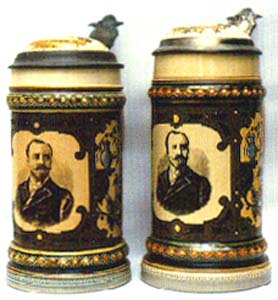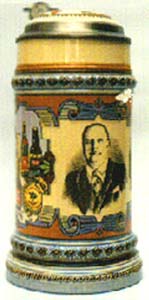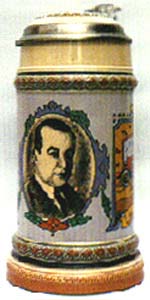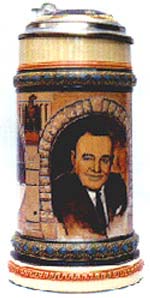
Brewers long ago discovered the advertising value of beer steins. What better way to sell the product of your brewery than to have its name on a drinking vessel designed specifically for the purpose of holding beer. Until recently, that’s about all there was to it. A brewer would typically contract with a steinmaker to produce a quantity of fairly standard and inexpensive “print under glaze” (PUG) steins with a recognizable logo. The steins were made for daily use and if one was accidently broken, it was no great loss.
While most brewery steins produced before 1975 were of the use-it-until-it-breaks variety, there have been some notable exceptions. Perhaps the most well-known of these among American stein collectors is the Mettlach stein (No. 2136) honoring Adolphus Busch, founder of the largest brewing company in the world. Centered on the front of the stein is a PUG line drawing of Busch himself. The remainder of the stein’s body is filled with a fairly elaborate combination of engraved and raised relief decoration. A porcelain inlaid lid features the “A & Eagle” Anheuser-Busch (A-B) logo, as well as a detailed pewter eagle thumblift.
Clearly, Mettlach No. 2136 was not a stein designed for regular use at the local beer garden. I’m not sure what it cost to own one at the end of the last century (it was first produced around 1893), but if you’d like to buy a mint example today, it will set you back somewhere between $2200 and $3000, depending mostly on how many “got-to-have-it” A-B stein collectors show up at the auction.
The high price for this stein (4 to 5 times higher than comparable Mettlachs) can be attributed largely to the fact that, in 1975 Anheuser-Busch began producing the first in a wide-ranging offering of steins that is now large enough to fill a catalog of some 300+ pages. Today that effort has literally redefined the term “brewery stein,” at least in the United States, and has resulted in an explosive growth among the ranks of beer stein collectors. During it’s first year of operation alone, the recently formed Anheuser-Busch Collectors Club attracted “nearly 40,000” members.
In the current Official Collector’s Guide To Anheuser-Busch Steins (1995 edition), among hundreds of far more recently produced items, one will find a picture and description of the original Adolphus Busch stein on page 81. Cataloging the stein, of course, alerted the army of A-B collectors to its existence, thereby creating a demand that far outstripped the available supply — hence, the high price.
The Anheuser-Busch Founders Series
 |
 |
The second stein in the Founders Series (Item No. CS226, Figure 2) honors August A. Busch, Sr., who took charge of the company in 1913 and was its guiding light during the Prohibition era, during which A-B survived by introducing a number of non-alcoholic products. Like the first in the series, this stein features a pen and ink portrait of the honoree. He is flanked on one side by a depiction of the products that carried the company through Prohibition and on the other by a scene of hops gathering in Bohemia. Also in line with the first in the series are the stein’s hand-painted raised relief decoration, an inlaid lid and the eagle thumblift.
The 1995 addition to the series (Item No. CS265, Figure 3) is, once again, matched to the its predecessors in all respects. The stein pays tribute to Adolphus Busch III, who is depicted along with the first Budweiser beer can from the 1930s and an early Anheuser-Busch yeast truck. According to information supplied with the stein, Budweiser yeast became a mainstay of the company’s product line under the younger Adolphus’ leadership.
The summer of 1996 saw the introduction of the fourth and final stein in the Founders Series (Item No. CS280, Figure 4) honoring August A. Busch, Jr., who ran the company from 1946 through 1974. In a slight departure from the earlier series releases, this stein is decorated with three depictions of Mr. Busch, all in color. On the front of the stein is an upper body portrait similar (but in color) to those found on the other steins. On one side, Busch is shown with one of the famous Clydsdale horses he introduced to the company shortly after Prohibition. On the other side, he is depicted sealing the 10 millionth barrel of beer brewed by Anheuser-Busch in 1964, representing a major annual production milestone.
 |
 |
It’s still a little too early to tell how the third and fourth steins in the series will do from a sales standpoint. Assuming aesthetics are a significant factor in the decision to buy, my guess is that August A. Busch, Jr. (CS280) will close the series on a winning note. The three color portraits surrounding the body of the stein help to produce a unified and pleasing overall impression that ought to draw a favorable response from the A-B faithful.
While the first two steins in the series are no longer being produced, it is still possible to find them on retailer shelves without too much effort. However, in light of their apparent lack of current popularity (they were originally projected to have production runs of 10,000 each), one can legitimately question whether or not they have the investment potential of some of the other A-B offerings.
Assuming you find the steins appealing enough to add them to your collection (always the primary consideration), the likelihood of price appreciation may well depend on your investment time horizon. Because these steins are at the top of the A-B line, with prices that put them out of range of many collectors, relatively low production numbers will almost surely result in their being among the “rarities” sought after by future generations of collectors. If you’re looking for a short-term windfall, these are not the steins for you. On the other hand, if you like the way they look and plan to keep them in your collection for the next twenty years or so, my guess is that by bucking the trend now you’ll eventually be able to make a substantial contribution to your personal retirement fund on the proceeds from their sale.
__________
*Reprinted by permission from Prosit, the Journal of Stein Collectors International, Vol 2, No. 21, March 1997